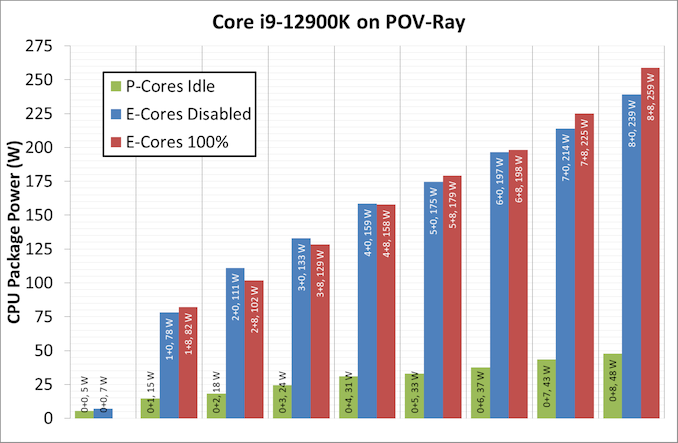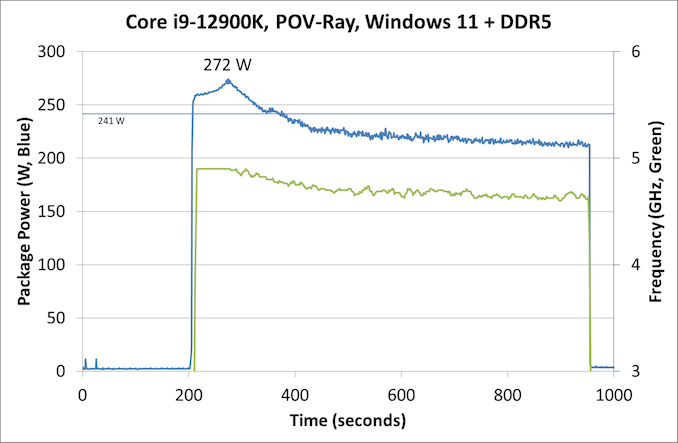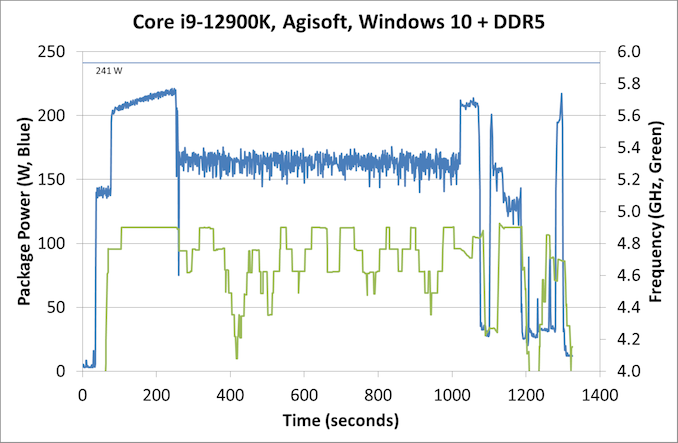The Intel 12th Gen Core i9-12900K Review: Hybrid Performance Brings Hybrid Complexity
by Dr. Ian Cutress & Andrei Frumusanu on November 4, 2021 9:00 AM ESTPower: P-Core vs E-Core, Win10 vs Win11
For Alder Lake, Intel brings two new things into the mix when we start talking about power.
First is what we’ve already talked about, the new P-core and E-core, each with different levels of performance per watt and targeted at different sorts of workloads. While the P-cores are expected to mimic previous generations of Intel processors, the E-cores should offer an interesting look into how low power operation might work on these systems and in future mobile systems.
The second element is how Intel is describing power. Rather than simply quote a ‘TDP’, or Thermal Design Power, Intel has decided (with much rejoicing) to start putting two numbers next to each processor, one for the base processor power and one for maximum turbo processor power, which we’ll call Base and Turbo. The idea is that the Base power mimics the TDP value we had before – it’s the power at which the all-core base frequency is guaranteed to. The Turbo power indicates the highest power level that should be observed in normal power virus (usually defined as something causing 90-95% of the CPU to continually switch) situation. There is usually a weighted time factor that limits how long a processor can remain in its Turbo state for slowly reeling back, but for the K processors Intel has made that time factor effectively infinite – with the right cooling, these processors should be able to use their Turbo power all day, all week, and all year.
So with that in mind, let’s start simply looking at the individual P-cores and E-cores.
Listed in red, in this test, all 8P+8E cores fully loaded (on DDR5), we get a CPU package power of 259 W. The progression from idle to load is steady, although there is a big jump from idle to single core. When one core is loaded, we go from 7 W to 78 W, which is a big 71 W jump. Because this is package power (the output for core power had some issues), this does include firing up the ring, the L3 cache, and the DRAM controller, but even if that makes 20% of the difference, we’re still looking at ~55-60 W enabled for a single core. By comparison, for our single thread SPEC power testing on Linux, we see a more modest 25-30W per core, which we put down to POV-Ray’s instruction density.
By contrast, in green, the E-cores only jump from 5 W to 15 W when a single core is active, and that is the same number as we see on SPEC power testing. Using all the E-cores, at 3.9 GHz, brings the package power up to 48 W total.
It is worth noting that there are differences between the blue bars (P-cores only) and the red bars (all cores, with E-cores loaded all the time), and that sometimes the blue bar consumes more power than the red bar. Our blue bar tests were done with E-cores disabled in the BIOS, which means that there might be more leeway in balancing a workload across a smaller number of cores, allowing for higher power. However as everything ramps up, the advantage swings the other way it seems. It’s a bit odd to see this behavior.
Moving on to individual testing, and here’s a look at a power trace of POV-Ray in Windows 11:
Here we’re seeing a higher spike in power, up to 272 W now, with the system at 4.9 GHz all-core. Interestingly enough, we see a decrease of power through the 241 W Turbo Power limit, and it settles around 225 W, with the reported frequency actually dropping to between 4.7-4.8 GHz instead. Technically this all-core is meant to take into account some of the E-cores, so this might be a case of the workload distributing itself and finding the best performance/power point when it comes to instruction mix, cache mix, and IO requirements. However, it takes a good 3-5 minutes to get there, if that’s the case.
Intrigued by this, I looked at how some of our other tests did between different operating systems. Enter Agisoft:
Between Windows 10 and Windows 11, the traces look near identical. The actual run time was 5 seconds faster on Windows 11 out of 20 minutes, so 0.4% faster, which we would consider run-to-run variation. The peaks and spikes look barely higher in Windows 11, and the frequency trace in Windows 11 looks a little more consistent, but overall they’re practically the same.
For our usual power graphs, we get something like this, and we’ll also add in the AVX-512 numbers from that page:

Compared to Intel’s previous 11th Generation Processor, the Alder Lake Core i9 uses more power during AVX2, but is actually lower in AVX-512. The difficulty of presenting this graph in the future is based on those E-cores; they're more efficient, and as you’ll see in the results later. Even on AVX-512, Alder Lake pulls out a performance lead using 50 W fewer than 11th Gen.
When we compare it to AMD however, with that 142 W PPT limit that AMD has, Intel is often trailing at a 20-70 W deficit when we’re looking at full load efficiency. That being said, Intel is likely going to argue that in mixed workloads, such as two software programs running where something is on the E-cores, it wants to be the more efficient design.














474 Comments
View All Comments
Wrs - Saturday, November 6, 2021 - link
@Netmsm I'll leave that to the market as I don't foresee using any of the 3 that soon lol. It would stand to reason that if one product is both cheaper and better, it would keep gaining share at the expense of the other. If that doesn't happen I would question the premise of cheaper + better. And seeing as it's a major market for Intel, I have little doubt they'll adjust prices if they do find themselves selling an inferior product.Netmsm - Sunday, November 7, 2021 - link
That's right. We always check performance per watt and per dollar. A product should be reasonable with respect to its price and power consumption, this is a must.12900k can consume up to 241 which is very closer to Threadripper not Ryzen 5900's TDP and yet competing with chips having 125 TDP! What a parody this is!
I can't disregard and throw away efficiency factor, that's all.
Spunjji - Friday, November 5, 2021 - link
Seeing this has made me very interested to see the value proposition Alder Lake will be offering in gaming notebooks. I was vaguely planning to switch up to a Zen 3+ offering for my next system, but this might be enough to make me reconsider.EnglishMike - Thursday, November 4, 2021 - link
<blockquote>re: Enterprise: Considering power consumption, it's like a Pyrrhic victory for Intel.</blockquote>Why? This is not an enterprise solution -- that's the upcoming Sapphire Rapids Xeon processors, a completely different CPU platform.
Sure, if all you're doing is pegging desktop CPUs at 100% for video processing or a similar workload, then Alder Lake isn't for you, but the gaming benchmarks clearly show that when it comes to more typical desktop workloads, the i9 12900k is inline with the top of the line AMD processors in terms of power consumption.
Netmsm - Thursday, November 4, 2021 - link
and who in his right mind would believe that upcoming Xeon processors can bring revolutionary breakthrough in power consumption?!EnglishMike - Friday, November 5, 2021 - link
And that, my friend, is a great example of moving the goalposts.We'll have to see what Intel offers re: Xeon's but one thing is for sure, they're going to offer a completely different power profile to their flagship desktop CPUs, because that's the nature of the datacenter business.
Netmsm - Saturday, November 6, 2021 - link
Of course the nature of enterprise won't accept this power consumption. In PC world customers may not care how ineffective a processor is. Intel will reduce the power consumption but the matter is how its processor will accomplish the job! We see an unacceptable performance to watt in Intel's new architecture that needs something like a miracle for Xeon's to become competitive with Epyc's.Wrs - Saturday, November 6, 2021 - link
No miracle is needed... just go down the frequency-voltage curve. Existing Ice Lake Xeons already do that. What's new about Sapphire Rapids is not so much the process tech (it's still 10nm) but the much larger silicon area enabled per package due to the EMIB packaging. That's their plan to be competitive with Epyc and its multichip modules.Netmsm - Sunday, November 7, 2021 - link
And what will happen to performance as frequency-voltage curve goes down?Just look at facts! With about 100w more power consumption Intel's new architecture gets itself in front of Zen 3 by a slight margin in some cases that lucidly tells us it can never reduce power consumption and yet beat Epyc in performance.
Wrs - Sunday, November 7, 2021 - link
@Netmsm I'm looking at facts. The process nodes are very similar. One side has both a bigger/wider core (Golden Cove) and a really small core (Gracemont). The other side just has the intermediate size core (Zen 3). As a result, on some benchmarks one side wins by a fair bit, and on other benchmarks, the other side takes the cake. Many benches are a tossup.In this case the side that theoretically wins on efficiency at iso-throughput (MC performance) is the side that devotes more total silicon to the cores & cache. When comparing a 12900k to a 5950x, the latter has slightly more area across the CCDs, about 140 mm2 versus around 120 mm2. The side that's more efficient at iso-latency (ST/lightly threaded) is the one that devotes more silicon to their largest/preferred cores, which obviously here is ADL. In practice companies don't release their designs at iso-performance, and for throughput benchmarks one may encounter memory and other platform bottlenecks. But Intel seems to have aggressively clocked Golden Cove such that it's impossible for AMD to reach iso-latency with Zen 3 no matter the power input (i.e., you'd have to downclock the ADL). That has significant end-user implications as not everything can be split into more threads.
The Epyc Rome SKUs are already downclocked relative to Vermeer, like most server/workstation CPUs. Epyc Rome tops out at 64 Zen3 cores across 8 chiplets. Sapphire Rapids, which isn't out yet, has engineering samples topping out at 80 Golden Cove cores across 4 ~400mm2 chiplets. Given what we know about relative core sizes, which side is devoting more silicon to cores? There's your answer to performance at iso-efficiency. That's not to say it's fair to compare a product a year out vs. one you can obtain now, but also I don't see a Zen4 or N5 AMD server CPU within the next year.